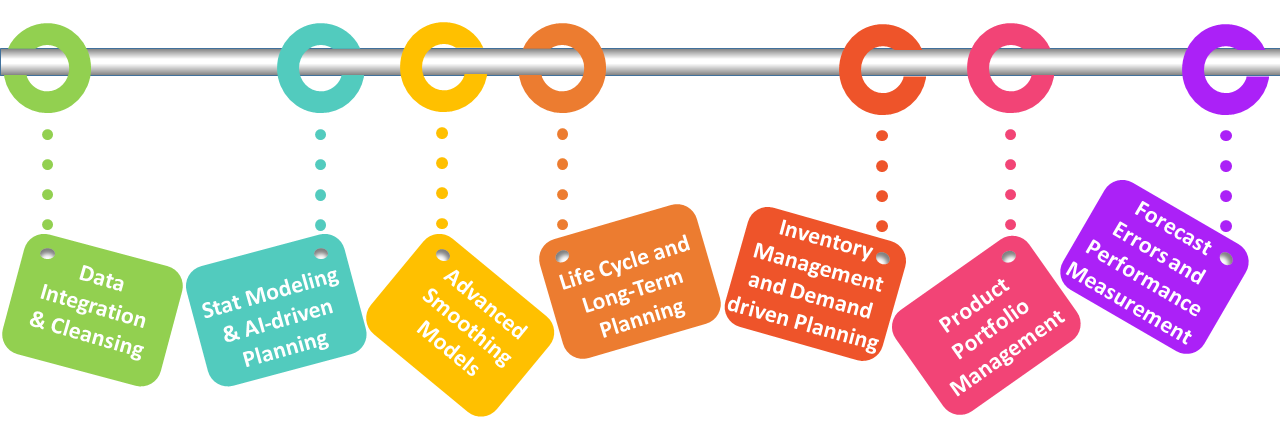Demand Planning, Sales Forecasting and S&OP :
In this specialized two-day course, we will discuss a variety of modern trends in Demand Planning and Supply chain forecasting – Machine Learning, AI-driven planning and Big Data analytics. The focus will be on demand modeling with AI-driven planning engines and statistical models, and the process to incorporate market intelligence. We will help you prepare for the role of a winning Data Scientist and a seasoned planning processional. And the two day workshop is the foundation for our Certified Analyst in Demand Planning – CADP program.
This workshop earns a Certificate and eligibility to sit for the CADP certification.
Download the Workshop Brochure Here!
.png)

Detailed Outline of The Workshop
|
Demand Planning Overview
- Planning objectives
- The Service – Cost – Balance Model
- Define your Plan
- Budgeting vs. Forecasting vs. Planning
- Beyond Statistical Forecasting
- Key Components of a Demand Plan
- Terminology in Planning – Forecast Horizon, Buckets & Periodicity
- Forecast Pass
- Demand Management
Data Integration and Cleansing
- It is all about the data
- The Forecast Problem and Data collection
- Define True Demand
- Data challenges
- Shipment Vs. Orders
- Gross Demand Vs. Net Demand
- Historical shifts in demand
- Data filtering
- Outliers– Identification and Correction
- The process to Identify Outliers
- Tolerance band
- Methodology for outlier correction
Stat Modeling and AI-driven Planning
- Demand Modeling
- Key components of demand
- Additive Vs. Multiplicative Seasonality in Models
- Modeling by decomposition
- Introduction to Forecast Modeling
- Qualities of a good statistical forecast
- Balancing between Model Fit Vs. Model Robustness
- Uni-Variate Time Series vs. Multi-Variate methods
- Moving Average
- AI-driven Planning and Expert Models
- Introduction to Planvida
Advanced smoothing models
- First Order Exponential Smoothing
- Holt Models to accommodate the trend
- Holt-Winters Model
- Exponential Trend and Dampening
- Interaction between components
Modeling special cases of Demand Product Life Cycle & Long-term Planning
- Product Lifecycle and trend • Launch Forecasting • Volume effect on line extension
- Event Modeling
Baseline vs. Incremental • Illustration of Event Models
- Planning for Intermittent Demand
What is Intermittent Demand & what causes it? Strategies to handle intermittent demand & Statistical Models for Intermittent Demand
- Higher-order Models
|
Product Portfolio Management
- Impact of Data Volatility on Forecasting
- Measuring Volatility
- Impact of multiple Extreme Observations on Volatility
- SKU Segmentation for demand modeling & inventory strategies
- Modeling by exception
- ABC analysis - Classification philosophy
- Pareto analysis based on dollar usage
- Item criticality
- Excess, obsolete and Slow-moving Alignment with the product lifecycle
- Discontinuance and end of life (EOL)
- Process flow for Segmenting SKUs
- Example using a three-dimensional matrix; ABC / Volume / Critical / Status; the excess, obsolete impact of Segmentation on Cycle Counting and Inventory Accuracy.
Demand Planning Analytics toolkit
Definition of Demand Forecast Errors
- Forecast Accuracy
- Forecast Bias vs. Forecast Error
- Error and Volatility Reduction
- Errors across SKUs vs. Errors across time
- Model Diagnostics vs Performance
- MAD
- MAPE vs. MPE
- WAPE
- Root Mean Squared Error
Measuring forecast performance
- Forecast Performance Metric
- Forecast errors and actionability
- Sources of Forecast Error
- Definition of Demand Planning Metrics - WAPE & Bias
- Types of Bias
- SKU Mix Error
- Error Analysis for Continuous Improvement
Why S&OP
- Fragmented Planning Activities
- – Supply chain challenges – Service, costs and inventories
- Disparities between the Financial forecast and operational forecasts
- Bottom Line challenges from Fragmented Planning
- Benefits of a holistic S&OP Design
- Core Components of SIOP
- Consensus Demand Planning
- Rough Cut Planning and Supply Collaboration
- Executive Presentation
- Demand-Supply Balancing
- Modeling by exception
|


.png)